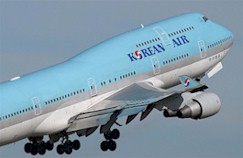Korean Air and Oracle asked
CA Advisors to design and deliver the best-in-class, industry-leading reliability
system for the airline’s MRO (maintenance, repair, overhaul) operations. The key objective was to place
Korean Air at the forefront of MRO reliability management
in the commercial aviation industry.
Oracle secured Korean Air
as a customer for cMRO (Complex MRO),
the Oracle’s premier ERP (enterprise resource planning)
application in the MRO space. In turn, CA Advisors was asked to incorporate a new highly-advanced reliability system
in the application’s Quality Assurance module during the implementation of cMRO.
The airline’s existing Reliability Control Program used the simplified exposure-rate method to quantify reliability. In
that method, the failure rate for parts, or the rate for any maintenance discrepancy, is determined by dividing the number
of failures/discreprencies by some measure of operational exposure, e.g., flight hours. The Mean Time between Failures
(or between discrepancies), which is also a measure for reliability, is then the reverse of that calculated rate. This
method, which is typically used in the industry, allows airlines to comply with the regulatory requirements concerning
reliability.
The exposure-rate method has limitations since reliability is quantified in a simple and crude way. The method does
not provide the needed reliability information that a sophisticated airline requires for decision making based on the
flight equipment inherent reliability.
CA Advisors designed the Korean Air’s new Reliability System based on the
principles of Reliability-centered Maintenance (RCM), which is the foundation of ATA
MSG-3 for developing maintenance programs
for the modern airliners. Those principles are guided by advanced statistical techniques that capture the inherent reliability of parts,
components, sub-systems, systems, and aircraft. The new Reliability System also utilized the proven standards for capturing the
age-survival characteristics.
A collection of Principal Reliability Models (PRMs) were used for representing the age dependency of item
survival. Unlike the exposure-rate method, this new and superior approach captures the randomness of failure/discrepancy
occurrences, and determines the survival probability up to any time. Subsequently for forecasting, the volume and timing
of removals/discrepancies are calculated for a given period. The accuracy of this new reliability-based forecasting
was benchmarked against the rate-exposure method, using CA Advisors’ AEMPS
solution. The results proved that the new reliability-based approach is markedly superior to the existing exposure-rate method.
CA Advisors also worked with Engineering, Planning, and Materials Management functional departments of the airline’s
Maintenance and Engineering Division to include the results provided by the new Reliability System in each department’s
business processes.
Please contact us for further detail.
|




